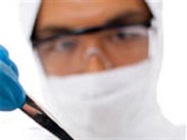 Sponsored by:
Sponsored by:

Forensic Science: Crime Lab Investigations
Forensic lab equipment is used to detect, collect and process samples and evidence from crime scenes, suspects and victims. Crime lab analysts apply the principles of biochemistry, genetics and molecular biology in the search for results. Forensic scientists are tasked with investigating a multitude of crimes using advanced technologies in every subfield of forensic science.
Some of the key measurements forensic labs perform include:
- Trace evidence analysis
- Fingerprinting and DNA identification
- Evaluation of body fluids
- Compound determination, such as drugs or other hazardous chemicals
- and more
What Does Forensic Analysis Comprise?
While the structure of forensic labs can vary, especially between private, public and government, a fully funded forensic laboratory often includes the following sections:
- Biology / DNA Analysis
- Drug Chemistry
- Forensic Toxicology
- Firearms / Toolmarks
- Latent Prints
- Trace Evidence Analysis
- Footwear / Tire Tracks
Certain forensic labs may also include more niche analysis sections, such as:
- Questioned documents
- Microscopy
- Crime Scene and Crash Reconstruction
- Digital Evidence
A Range of Instrumentation
Forensic laboratory equipment ranges from instrumentation you would see in a general laboratory, such as microscopes, fume hoods, chromatographs and spectrometers, to equipment used for specific forensic analysis, like cyanoacrylate fuming chambers for lifting of latent fingerprints.
Alternative light sources are used frequently both at the crime scene and in the laboratory, in addition to cameras and video recording devices. Analysis of digital evidence, like phones and computers, requires high-tech extraction software and analysis tools.
What Are The Key Considerations for Purchasing Forensic Laboratory Equipment?
When equipping a forensic laboratory, the cost of purchasing and maintaining instrumentation and equipment is always the first considerations. In a forensic lab, the second tends to be analysis runtime. Due to increasing reliance on forensic analysis in criminal investigations—and a lack of personnel—many forensic labs have faced mounting workloads and backlogs. Employing instrumentation and equipment that is automated, fast and accurate allows forensic professionals to move on to the next case as quickly as possible.
Newsworthy in Forensic Science
Since the start of the 20th century, forensic science has experienced an explosion of advanced technologies, some of which has revolutionized the way analyses is performed. The emergence of advanced DNA analysis techniques, like next-generation sequencing (or massively parallel sequencing), forensic software for complex, mixed DNA profiles and investigative genetic genealogy has uncovered investigative leads and answers that were previously unattainable. Visit
Forensic® for more information on the latest technology and news.
By submitting a product review you are not only sharing your experiences with others, but also gaining helpful insight from others in the research community.
Submit a Review